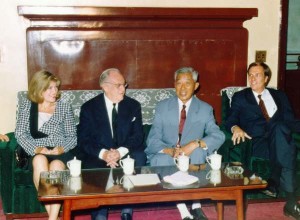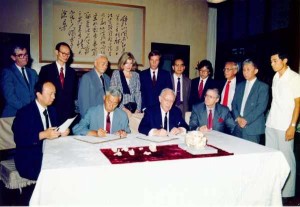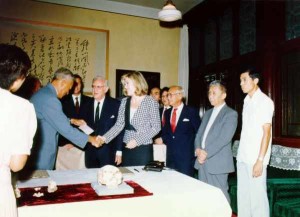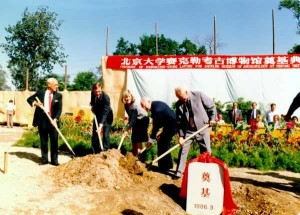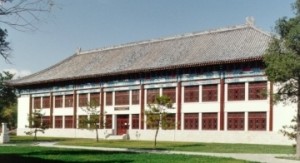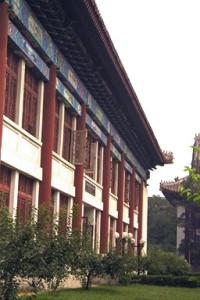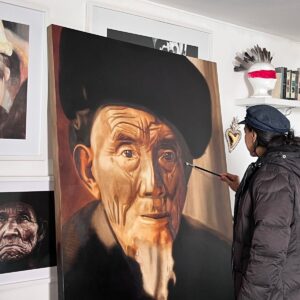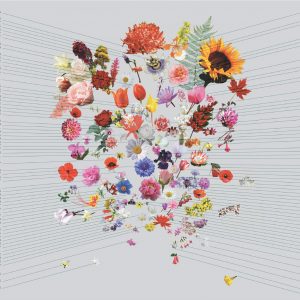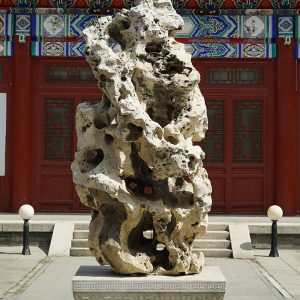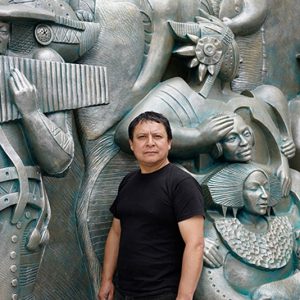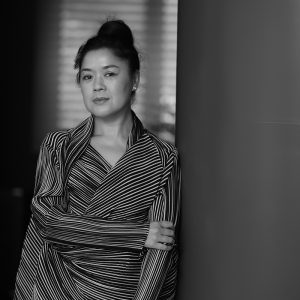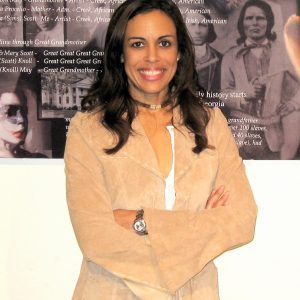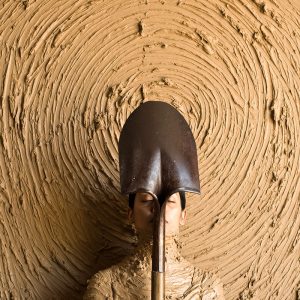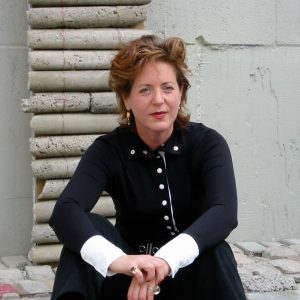Dr. Arthur M. Sackler expressed his interest in helping China preserve its rich cultural heritage by offering to provide a teaching museum incorporating all elements of modern museology, such as modern display techniques, climate control, conservation facilities, storage and security, as well as a training program for archaeologists and museologists. Discussions about the construction of such a museum were officially entered into in 1984 with the Secretary General of Peking University, Mr. Wen Zhong. Peking University is the logical choice for the museum because of its extensive archaeological collection and because it has been a leader in training Chinese archaeologists since the nineteen-thirties.
A Declaration of Intent was signed by Dr. Sackler and Dr. Ding Shisun, then President of Peking University, to build the museum, on September 8, 1986, the day of the groundbreaking ceremony. The actual construction of the museum and the completion of the museum project had been overseen by Dr. Sackler’s widow, Jillian Sackler.
The new museum is located on a beautiful site near the West Gate of Peking University campus and its architecture takes the inspiration from buildings that already exist on campus. The firm of Prentice & Chan, Ohlhausen, of New York City, was hired to design the museum in July, 1986, with Lo-yi Chan, working closely with the Peking University staff and in consultation with Dr. Sackler, as the supervising architect for the project. The new museum was designed to conform to Ming Dynasty style structures, around a central courtyard.
In May 1987, Jillian Sackler, on behalf of the AMS Foundation for the Arts, Sciences and Humanities, signed an additional agreement that provided for the expansion of the project to include the extensive but long abandoned gardens that lay to the west of the site. These had formerly been part of the grounds of Yuanming Yuan, the Old Summer Palace, that had been destroyed in 1860, and were called the Singing Crane Gardens. These gardens have been beautifully restored and provide a future site for the placement of sculpture to create The Jillian Sackler Sculpture Garden.
The Opening Ceremonies took place on May 23, 1993, with a ribbon-cutting ceremony, and festivities including an indoor/outdoor gala dinner with traditional cuisine from China, Japan, the Middle East and The United States of America.
In honor of the occasion, a four-day scholarly conference, titled Chinese Archaeology Enters the Twenty-first Century took place from May 28 through May 31, 1993. This was the first meeting of Eastern and Western archaeologists in decades. It served as a forum to discuss new scholarship and advances in the field of Chinese art and archaeology, and to set the agenda for future collaborative research in Chinese archaeology. Archaeologists from the United States, Europe, Japan, Hong Kong, Taiwan, Macao and Singapore were invited to participate with colleagues from all regions of China. The conference, which over one-hundred scholars attended, was conducted in Chinese and English and ended with a special visit to an archaeological site within the vicinity of Beijing. It was sponsored by the AMS Foundation for the Arts, Sciences and Humanities, and co-organized with the Department of Archaeology of Peking University. The publication of this conference, entitled “Proceedings of the International Conference on ‘Chinese Archaeology Enters the Twenty-first Century’“ is available through this site.
HISTORY OF THE COLLECTION AT PEKING UNIVERSITY
The collection of Chinese art and artifacts currently housed in this new museum on the campus of Peking University contains more than 10,000 objects and spans a period of 280,000 years, from Paleolithic hominids and stone tool remains to costumes, ceramics and paintings of the present era. The collection, which is used for teaching and research purposes, has been acquired during the past seventy years from diverse sources.
In 1922 China’s first Archaeology Research Office was set up at Peking University. The office launched a fieldwork program, and through this program Peking University gradually began to build a collection of archaeological remains. A few years later together with the creation of the Peking University Museum, a special museum training course was created. At this time, in addition to excavated artifacts, the museum’s collections expanded to include antiquities from the antiquity market, and ethnographic materials.
In 1952 Peking University moved to its current location in the Haidian District on the outskirts of Beijing. In doing so it moved onto the campus of the former Yanjing University, an American college established in 1920 which closed its doors shortly after 1949. A Prehistory Museum at Yanjing University, with its own collections, had also existed there. After 1952, its collections were transferred to the newly formed Archaeology Division at Peking University.
Since 1952 the archaeologists at Peking University have continually added to their collection through their extensive fieldwork program. In 1983, when the Archaeology Division acquired full department status, they further expanded their fieldwork activities. Archaeologists from Peking University have worked all over China, but they have concentrated their research on sites in the Central Plains and the north. They have excavated in Shaanxi, Shanxi, Henan, Hebei, Liaoning, Xinjiang, Shandong, Hubei and Jiangxi.
With the creation of the Arthur M. Sackler Museum of Art & Archaeology at Peking University, the collections have grown even more through the generous loans and gifts made by archaeological institutions from all over China. These contributions have been made to celebrate the opening of this new museum which is expected to play an important role in the field of Chinese archaeology and museology.
Exhibitions
Permanent Exhibition
A permanent Exhibit on Chinese Archaeology, dating from 280,000 years ago to the 17th century. Objects on display include Bronzes, Jades, Pottery, and Bone artifacts. These objects were either excavated by the students and staff from the Archaeology Department, collections from Yanjing University and Peking University, and loans from other archaeological institutions in China.
Special Exhibition
The Treasure of He Jiacun
The Jinniushan Man, dates from 280,000 years ago.
The Changdao Neolithic Settlement of 5000-4000 years ago.
Artifacts from the cemetery of the Jin State, Western Zhou Dynasty, 11 Century BC
International Exhibitions
The Dame Jillian Sackler International Artists Exhibition Program was established to bring talented international artists to the Sackler Museum at Beida. Artwork for this program must have cultural value in order to create an open dialogue between the work and the viewer. It is our mission to have exhibitions that are informative, exciting, interactive and most of all thought-provoking. The aim of this program is to create cross-cultural understanding and promote lasting relationships between peoples by bringing works by artists from diverse backgrounds to China.
Visiting Hours
Opens Daily
9:00am to 4:30pm (except holidays)
Free Admission
Visitors should go to the West Gate of the University and tell the guards that they would like to see the museum. (Please bring your passport with you, you may be asked to fill out a form and the passport number is required.)
If visiting in a group, in China, please contact Vice-Director Cao Hong (86-10-6276-5711) or Dr. Lu (86-10-6275-7151), via fax at (86-10-6275-1667), in the U.S. contact the Dame Jillian & Dr. Arthur M. Sackler Foundation for the Arts, Sciences & Humanities (AMS Foundation for the Arts, Sciences and Humanities) via e-mail: info at sackler.org / amsfash at aol.com
★ The Museum offers English, Japanese & Chinese tours by request.
- Mrs. Sackler, Dr. Sackler, Dr. Ding Shisun and U.S. Ambassador Winston Lord
- Signing of the Agreement
- Mrs. Sackler presents first payment to President Ding Shisun in September, 1986
- Dr. Jean Mayer, U.S. Amb. Winston Lord, Mrs. Sackler, Dr. Sackler, Minister Qian Xinzhong
- Arthur M. Sackler Museum of Art and Archaeology at Peking University, Beijing, China
- Arthur M. Sackler Museum of Art and Archaeology at Peking University, Beijing, China
